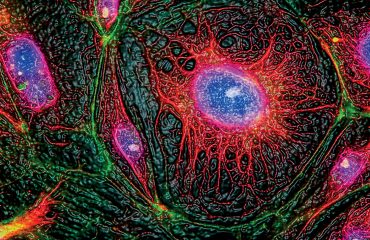Marianne J. Legato, MD, PhD (hon.c.), FACP
GENDER AND THE GENOME Volume 1, Number 3
The world we are living in seems to be in an unprecedented state of perpetual crisis: nations are changing leadership and direction; a new level of life-threatening bellicosity saturates the daily news. The planet itself seems to be in a terrifying state of flux. We endure unprecedented extremes of temperature, floods, and murderous droughts dry up the food supply of whole populations, hurricanes and tornadoes swoop down to destroy huge swaths of terrain, arctic ice is melting, and seas are so contaminated that whole classes of the organisms that live in them are becoming extinct. It is no wonder that a general sense of anxiety and apprehension seems to saturate the very air we breathe. Previously reasonably happy, confident individuals complain of insomnia, restlessness, and a nameless feeling of dread. We are paying a very real price for the tumult we are experiencing.
In fact, (and as usual) we are confronted with the stunning contrast between our lethal destructiveness and our resilient, remarkable creativity. On one hand, we are poised on the brink of extinction in struggles largely of our own making (one pundit when asked what he thought of the current state of the world said he was headed for permanent occupancy on the international space station). On the other, despite all the catastrophes around us, we are doing amazing things: we defined the structure of the human genome less than two decades ago, but have already have learned how to explore and change its composition in a simple, profoundly effective maneuver.1 Most recently, molecular biologists removed a defective gene from a human embryo that if allowed to fully develop, presumably would live free of hypertrophic cardiomyopathy. 2
So, despite environmental turmoil, we continue to work at answering some of the most critical questions humans have ever asked. One of the most important is to unravel the mechanism of how experience impacts function and behavior. Our awareness of the fact that the environment shapes us did not originate with Darwin; it is a fundamental, self-evident concept that arguably has existed since humans first appeared on the planet. Accordingly, it was inevitable that when we began to acknowledge the differences between males and females and coined the phrase ‘‘gender-specific medicine,’’ a significant and contentious divide was immediately apparent between sociologists and biologists. Anthropologists routinely accused physiologists of ignoring the impact of social, cultural, and economic forces on men and women’s behavior. Biologists, in contrast, concentrated on chromosomal sex as the exclusive determinant of function. They largely ignored the sociocultural contribution to the individual, viewing it as unquantifiable: too heterogeneous and too complex—too fuzzy—to integrate into their worldview. Thus, the nomenclature of the science of the differences between males and females has been ambiguous and confusing from the start: most biologists used ‘‘sex-specific’’ to describe their data, whereas anthropologists and sociologists generally used a broader term, that is, ‘‘gender,’’ to mean the result of the impact of the environment on the individual. We have more or less accepted ‘‘gender-specific medicine’’ as the term that includes both. What we never knew, though, is precisely how the environment shaped function, nor did we appreciate the range of ways in which it did so.
The new discipline of epigenetics, the science of how genomic expression is controlled and modified, has provided us with entirely new insights into how phenotype is shaped and maintained. The environmental stimulus induces chemical modifications at critical sites on DNA, silencing or activating specific genes. More recently, we are uncovering the mechanics of a similar modification of RNA in a discipline christened the epitranscriptome. 3 Thus, we are constantly changing in response to experience.
New insights confirm the importance of sex to function: the first investigations of how epigenetics works on DNA, and more recently on the various components of genomic RNA, begin to make it evident that an identical environmental stimulus in many if not all instances has a sex-specific effect. McCarthy and Arnold point out that the sex differences in the brain are not only the consequence of XX or XY chromosomes or the hormones they engender, but they also urge us to integrate the effects of the environment on gender-specific brain biology. They comment in a recent review:
The effect of environment is rarely controlled for or empirically tested, but environmental and biological factors likely interact in complex ways to sculpt the female and male phenotype. Sex differences in the environment have an enormous effect on gender in humans and are arguably more potent in sculpting the gender-based social phenotype of humans. There is virtually nothing known about the biological basis for these environmental effects, but the rodent literature (epigenetic effects of early stress, differences in maternal behavior) hints at epigenetic mechanisms that could mediate environmental effects on the brain throughout the lifespan. 4
The timing of exposure to environmental stimuli is very relevant to susceptibility to epigenetic changes, and may also determine whether with subsequent environmental signals, they can be reversed. Heim and Binder point out the singular importance of specific periods in embryonic and early life (in humans, between 1 and 3 years of age) during which young animals develop a matrix for the development of depression in response to early stress. These experts postulate that the responsiveness of the same genes that confer risk for depression if modified by a positive environment in a timely way during development can neutralize that risk by epigenetic modification of that gene.5
Epigenetic changes can be transmitted across generations. Depending on whether environmental factors affect the ovum or sperm, progeny inherit traits and do so sometimes in a sex-specific way. 6,7 How this occurs is unclear because two rounds of epigenetic changes are eliminated and reconfigured during the process of gonadal determination of offspring; what protects some changes from erasure is not known. The extent and sophistication of the new frontiers in epigenetics and the epitranscriptome attest to the complexity of the mechanisms that translate experience into normal physiology and susceptibility to disease. Happily, we respond in real-time and with admirable plasticity to every environmental signal we experience. In this issue of Gender and the Genome, a panel of experts explores some of the most exciting new developments in the field and presents us with abundant evidence that, as Doctor Einstein so elegantly phrased it, the world does indeed write upon the body.
References
1. Charpentier E, Doudna JA. Biotechnology: rewriting a genome. Nature 2013;495:50–51.
2. Ma H, Marti-Gutierrez N, Park SW, et al. Correction of a pathogenic gene mutation in human embryos. Nature 2017; 548:413–419.
3. Saletore Y, Meyer K, Korlach J, et al. The birth of the Epitranscriptome: deciphering the function of RNA modifications. Genome Biol 2012;13:175–186.
4. McCarthy MM, Arnold AP. Reframing sexual differentiation of the brain. Nat Neurosci 2011;14:677–683.
5. Heim C, Binder EB. Current research trends in early life stress and depression: review of human studies on sensitive periods, gene-environment interaction and epigenetics. Exp Neurol 2012;233:102–111.
6. Pembrey ME, Bygren LO, Kaati G, et al. Sex-specific, maleline transgenerational responses in humans. Eur J Hum Genet 2006;14:159–166. 8. Huypnes P, Sass S, Wu M, et al. Epigenetic germline inheritance of diet-induced obesity and insulin resistance. Nat Genet 2016;48:497–499.
7. Huypnes P, Sass S, Wu M, et al. Epigenetic germline inheritance of diet-induced obesity and insulin resistance. Nat Genet 2016;48:497–499.
Marianne J. Legato, MD, Ph. D. (hon. c.), FACP is an internationally renowned academic, physician, author, lecturer, and pioneer in the field of gender-specific medicine. She is a Professor Emerita of Clinical Medicine at Columbia University College of Physicians & Surgeons and an Adjunct Professor of Medicine at Johns Hopkins Medical School. Dr. Legato is also the Director of the Foundation for Gender-Specific Medicine, which she founded in 2006 as a continuation of her work with The Partnership for Gender-Specific Medicine at Columbia University. She received an honorary PhD from the University of Panama in 2015 for her work on the differences between men and women.
At its core, gender-specific medicine is the science of how normal human biology differs between men and women and how the diagnosis and treatment of disease differs as a function of gender. Dr. Legato’s discoveries and those of her colleagues have led to a personalization of medicine that assists doctors worldwide in understanding the difference in normal function of men and women and in their sex-specific experiences of the same diseases.
She began her work in gender-specific medicine by authoring the first book on women and heart disease, The Female Heart: The Truth About Women and Coronary Artery Disease, which won the Blakeslee Award of the American Heart Association in 1992. Because of this research, the cardiovascular community began to include women in clinical trials affirming the fact that the risk factors, symptoms, and treatment of the same disease can be significantly different between the sexes. Convinced that the sex-specific differences in coronary artery disease were not unique, Dr. Legato began a wide-ranging survey of all medical specialties and in 2004, published the first textbook on gender-specific medicine, The Principles of Gender-Specific Medicine. The second edition appeared in 2010 and the third edition, dedicated to explaining how gender impacts biomedical investigation in the genomic era, won the PROSE Award in Clinical Medicine from the Association of American Publishers in 2018. A fourth edition is forthcoming.
She also founded the first scientific journals publishing new studies in the field, The Journal of Gender-Specific Medicine, and a newer version, Gender Medicine, both listed in the Index Medicus of the National Library of Medicine. She has founded a third peer-reviewed, open access journal, Gender and the Genome, which focuses on the impact of biological sex on technology and its effects on human life.
Dr. Legato is the author of multiple works, including: What Women Need to Know (Simon & Schuster, 1997), Eve’s Rib (Harmony Books, 2002), Why Men Never Remember and Women Never Forget (Rodale, 2005), Why Men Die First (Palgrave, 2008), The International Society for Gender Medicine: History and Highlights (Academic Press, 2017), and most recently, The Plasticity of Sex (Academic Press, 2020). Her books have been translated into 28 languages to date.
As an internationally respected authority on gender medicine, Dr. Legato has chaired symposia and made keynote addresses to world congresses in gender-specific medicine in Berlin, Israel, Italy, Japan, Panama, South Korea, Stockholm, and Vienna. In collaboration with the Menarini Foundation, she is co-chairing a symposium on epigenetics, Sex, Gender and Epigenetics: From Molecule to Bedside, to be held in Spring 2021 in Italy. She maintains one of the only gender-specific private practice in New York City, and she has earned recognition as one of the “Top Doctors in New York.”





